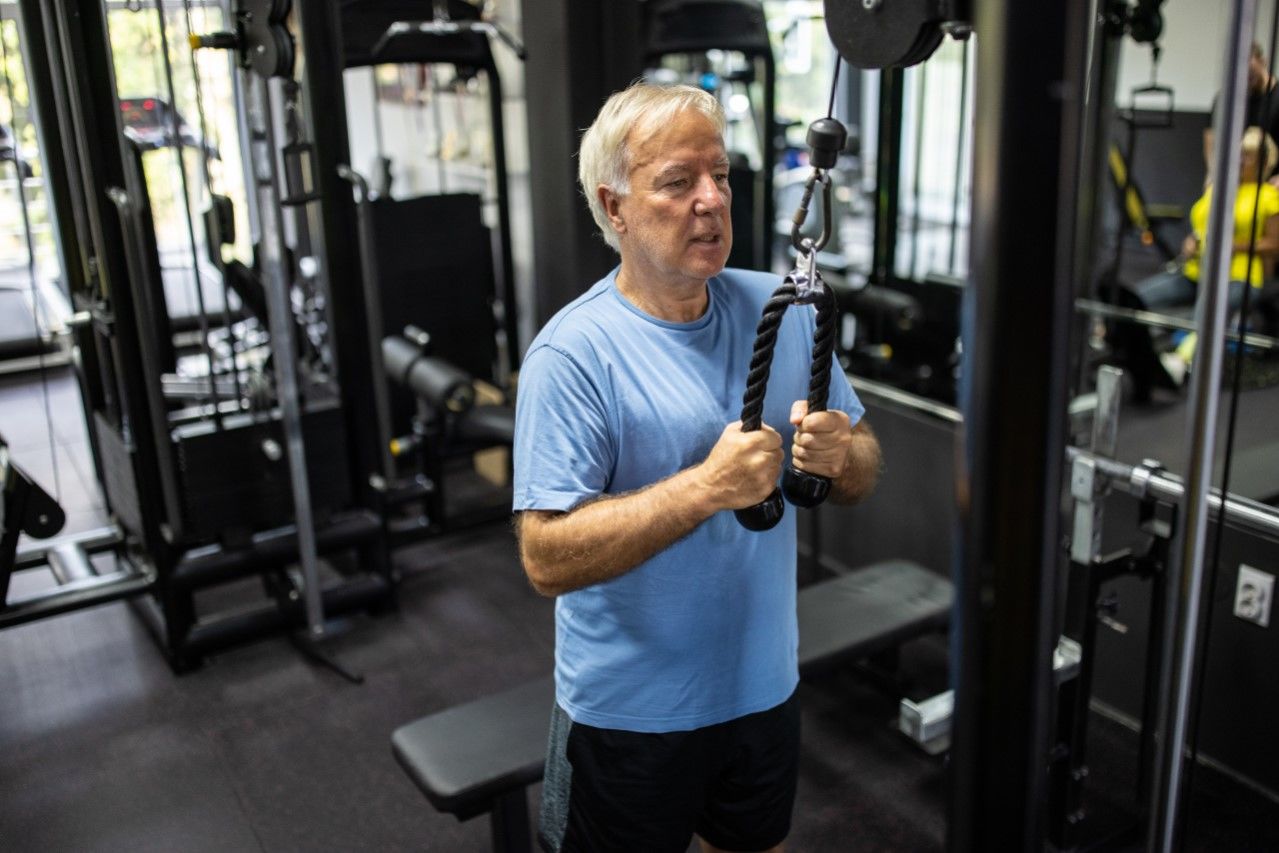Fitness and lifting weights
You are thinking about lifting weights, but where to start? This expert advice could put your mind at ease.

Key points
- There are four types of physical activity suited to ageing.
- Weightlifting/resistance has many benefits if done correctly.
- Lower intensity means you will need to do a lot of reps to have a positive benefit.
Before talking about weightlifting, did you know there are four main types of physical activity we should be doing as we age?
They are:
1. Cardiovascular (‘cardio’) fitness activities help keep your heart and lungs healthy:
- Brisk walking
- Cycling
- Swimming
- Golf (without a golf cart)
- Tennis
- Aerobics classes
- Dancing
2. Flexibility. Gentle stretching and bending exercises that help you move more easily:
- Tai Chi
- Yoga
- Dancing
- Gardening
- Lawn bowls
- Mopping or vacuuming
3. Balancing activities help improve your balance, which can help prevent falls:
- Side leg raises
- Half squats
- Heel raises
4. Strength activities help keep muscles and bones strong. Strength training and weight-bearing exercise are especially helpful in increasing bone density and reducing the risk of falls among people with osteoporosis:
- Weight training
- Resistance training
- Lifting and carrying (for example, groceries or small children)
- Gardening (involving digging and lifting)
- Climbing stairs
Aim to build strength exercises into your routine about 2 to 3 times a week.
Mandy Hagstrom is an exercise scientist (former Commonwealth powerlifting medallist and national Olympic weightlifting champion) who researches resistance training, also known as lifting weights.
Writing in The Conversation, she said research suggests lifting smaller weights and doing more repetitions (or, in gym parlance, reps) can have a role to play – but it all depends on your goals.
Here is her advice on building strength.
However, it is not specific to older people. Before you start lifting weights, consult your doctor and fitness program experts.
If your goal is to build serious strength and bone density, lifting heavy is an efficient way to do it. But if you cannot lift heavy or it is not your thing, please do not think lifting lighter weights is a waste of time.
What is heavy for one person may be easy for another.
In resistance training, the load or “heaviness” of weight is expressed as a percentage of a “one repetition maximum” (frequently shortened to “1RM”).
A one-repetition maximum is the heaviest load you can successfully lift once.
Around 80 per cent of your one repetition maximum is defined as “high intensity” or heavy lifting.
Around 40 per cent or less of your one repetition maximum is defined as “low intensity”.
In other words, lifting 80 per cent of your one repetition maximum would allow you to do about eight reps.
The more reps we do, the less accurate the relationship.
But some estimates predict you could do 20 reps at 60 per cent of your one repetition maximum (of course, it varies depending on the person).
Not everyone can lift heavy due to age, injury, or just being new to the gym. Perhaps while you cannot lift heavy now, it does not mean that will always be the case.
The key is: if you are training at a lower intensity, say 40 per cent of your one repetition maximum, you will need to do a lot of reps to have a positive benefit.
Lifting loads ranging from 40 per cent to 80 per cent of your one repetition maximum have been shown to elicit improvements in muscle mass (hypertrophy). However, research also demonstrates that lifting at higher loads is needed to maximise improvements in muscular strength.
High-intensity exercise is the most effective exercise for maintaining and improving bone health. Research has shown the best approach for bone health is combining high-intensity resistance and impact training.
Research has shown participation in high-rep, low-intensity BodyPump™ classes may offset age-related reductions in lumbar spine bone mineral density.
If you choose to lift lighter weights, you will need to do more reps to get the same benefits lifting heavy would yield.
On average, a one-hour low-intensity/high-rep style resistance training session may burn about 300 calories.
A heavy session with longer rest periods has the same calorie burn as a higher rep session with less rest.
There may also be sex differences in how people respond to resistance training.
For example, older men may benefit from higher-intensity programs, whereas older women may benefit from higher-volume programs (more repetitions).
Doing low-load training without considerable effort is unlikely to result in huge improvements in muscle growth and strength. So, if you choose this style, ensure you are ready to put in the effort.
Author: Mandy Hagstrom - Senior Lecturer, Exercise Physiology. Director of Teaching and Education, School of Health Sciences, UNSW.
For further reading: The Conversation and Health Direct







